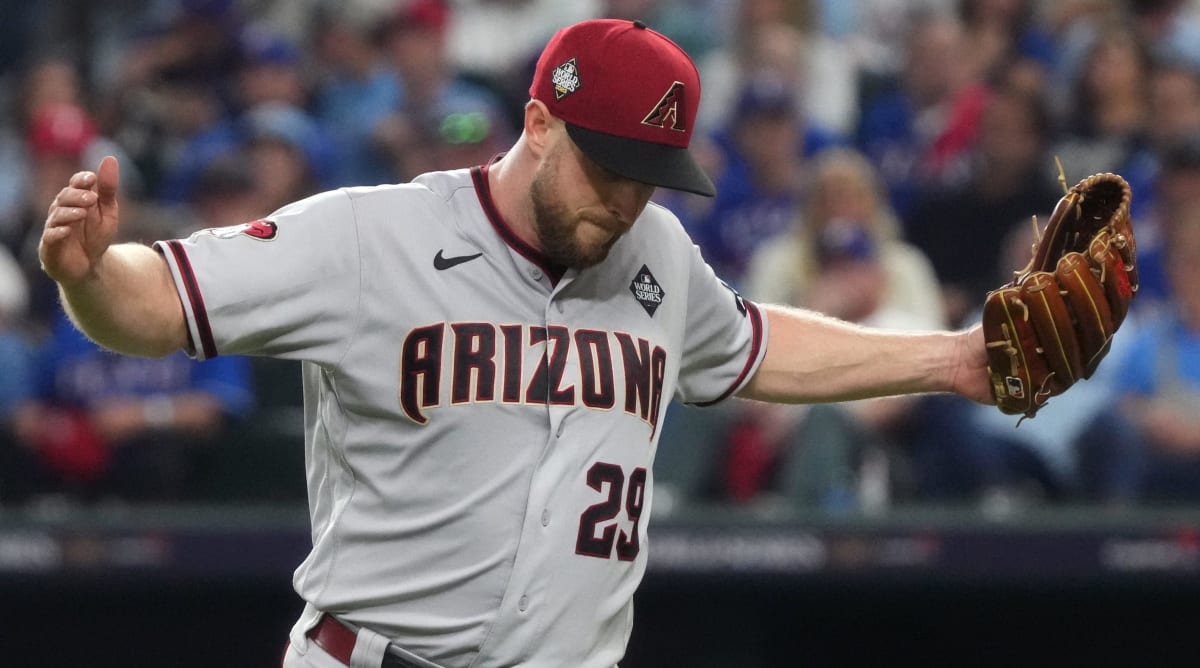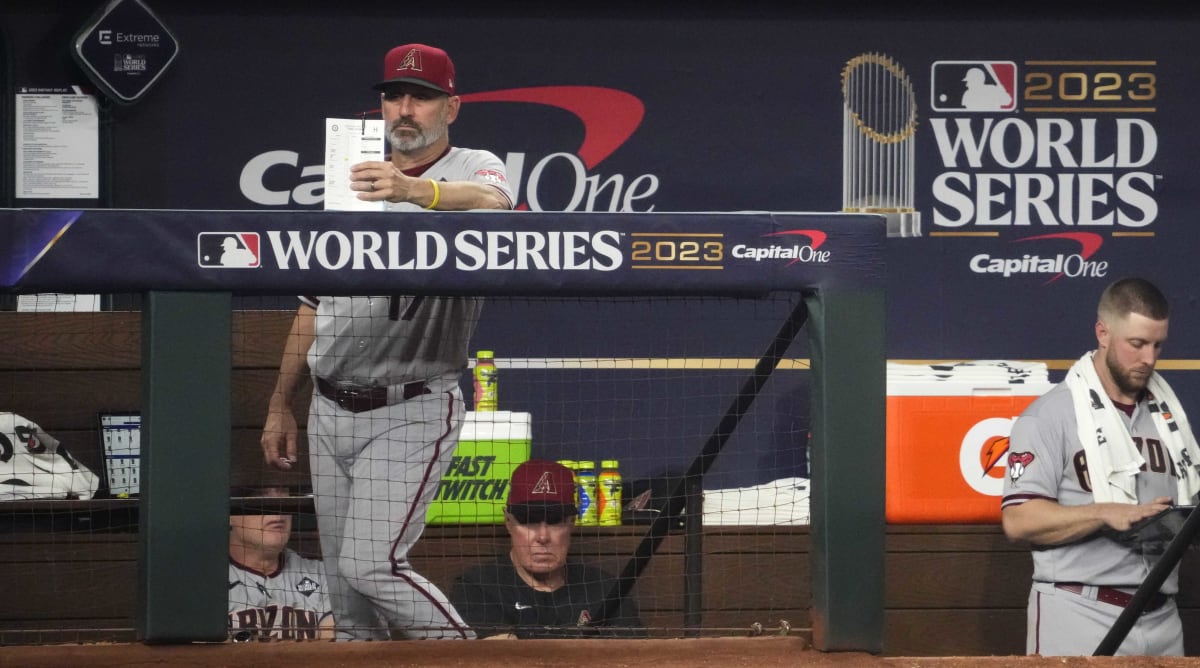ARLINGTON, Texas — You know the story is going to be a good one when the teller of the tale begins, “It’s a real story. It’s true.”
The spinner of the yarn was Diamondbacks manager Torey Lovullo. The subject was Arizona pitcher Merrill Kelly, who had just put on such an exquisite exhibition of pinpoint pitching Saturday night that there are only six other games like it in the history of the World Series. Kelly was that good—historically good—as the D-Backs emphatically seized Game 2, 9–1, to square the series.
On nights like this, when Kelly placed his palette of pitches on the edges of the strike zone with the exactness of a pointillist, to understand who Kelly is means going back to that true story, when his own manager called him “the worst starting pitcher in baseball.”
“It's kind of an embarrassing topic,” Lovullo says, “but he's as good as anybody at taking something and using it to push himself.”
It was 2019. Kelly had signed with Arizona after pitching four years in Korea, a lengthy study abroad tenure after he was buried so far in the Tampa Bay system that he wanted out. Finally given a chance to pitch in the big leagues as a 30-year-old rookie, Kelly was carrying an ERA nearing five into the middle of August.
Lovullo had seen enough from Kelly. The manager cares about his players. If he is thinking about making a move with playing time or roles, he will run his thoughts by the player rather than pulling the trigger without warning.
“Which is typically what I do,” Lovullo says. “I don't just blast it, or just pull the rug out from under you. I gave him a heads up.”
Lovullo called Kelly into his office.
“This is what I’m thinking,” the manager told him. “Either you get better, or I’m gonna push you out the door. I’m putting you on notice.”
Kelly is a thinker, a problem-solver and a deep preparer for when he takes the ball. He doesn’t operate on emotions. He wants reasons. He asked Lovullo for reasons.
“You are statistically the worst starting pitcher in the National League,” the manager said. “And I've stuck with you a long time. I want this to be your position in the rotation, but you have got to show me that you can take it.
“I’m sorry, but that’s the truth. And that’s how I operate.”

Joe Rondone/The Republic/USA TODAY NETWORK
Kelly responded by making some technical adjustments to his delivery. He poured himself into his craft even more. He had spent his entire baseball career trying to prove to people he was better than what they thought and the mission to do the same to Lovullo sharpened his edge. He soon went on a run. He finished that season 4–1 with a 2.18 ERA in five September starts, far from being the worst pitcher in the league. The arc of his career, what little it was at the point, changed.
“He accepted it,” Lovullo says of the challenge. “And he has referenced it himself. I don't necessarily talk about it unless he does.”
Says Arizona pitcher Zac Gallen: “I had just got here [in a trade] and I was in Milwaukee. That was probably what, my second or third start here. So, I didn’t even know that it happened. I found out about that after the fact.
“That's Merrill, though. It's like, ‘All right, sure. I'll prove you wrong. I know what I got left in the tank.’ It was the same thing with the Rays not giving him a shot. He’s like, “All right, I’ve got a lot of good baseball in me. I’ll go to Korea and hone my game.’ That’s Merrill.
“I mean, he’s the most undervalued starting pitcher in baseball.”
Since that challenge from Lovullo, Kelly is 39–30 with a 3.52 ERA over 100 starts. Over the past two seasons he is 25–16 with a 3.33 ERA and the 10th most innings.
You must understand the context of how the ball came to him in World Series Game 2 to fully appreciate his master class. The Rangers had stolen a Game 1 win right out from under the D-Backs with a shocking two-run, game-tying home run in the bottom of the ninth from Corey Seager and a walkoff homer in the 11th from Adolis García, his fifth straight game with a homer.
“We needed to win this game,” Lovullo says. “It was big. It was a big momentum game. It felt like that if we got squashed early in this game, their momentum would have worked right through this game. Merrill went toe-to-toe with [Jordan] Montgomery for the first couple of games. I felt like we were in a good spot. It was all about him today.”
Kelly went to work, performing a kind of laser surgery on the edges of the zone. It took only 20 pitches for Lovullo to know Kelly was at his surgical best. After the second inning, Lovullo said to himself: “He’s got a really good changeup tonight.”
The changeup had so much depth that on several occasions it appeared to be a slider from Lovullo’s vantage point in the third base dugout. Then he’d look up on the scoreboard and see the speed and how the pitch was identified as a changeup.
The hot bats in the Texas lineup went cold under the exactness of Kelly’s pitching.
“I go into every game trying to dot every single pitch I throw,” Kelly said. “I want to throw it right on the edge the best I can to my ability every single time I go out on that mound and every single bat that I have. Just obviously, some games it works out better than others.”
He has pitched deeper into games and had more strikeouts in games, but he never pitched so expertly with so much on the line as he did in Game 2. The guy who went halfway around the world and back to earn his first big league job at 30 finally reached the World Series at age 35 and started in something of a must-win game in his manager’s eyes.
And all Kelly did was go seven innings with no walks and nine strikeouts. Only seven other pitchers had ever covered seven or more innings with no walks and that many strikeouts: Clayton Kershaw (2017), Cliff Lee (2009), Curt Schilling (2001), Roger Clemens (2000), Don Newcombe (1949) and Deacon Phillippe (1903, in the first World Series game ever played). Only Clemens, then 38, was older than Kelly at the time of his gem.
“At this point in my career, nothing is going to shock me,” he said. “I think going over to Korea as a 26-year-old is way scarier than pitching in the big leagues or even in the World Series, to be honest with you. There was just so many unknowns at that age. Obviously with my baseball career, the choice to go over there, the culture, leaving my family. I think that was the biggest pressure.
“And I think at this point in my career ... I just turned 35. I'm definitely closer to the end of my career than I am the beginning. So, I'm just trying to enjoy it as much as I can and not make anything bigger than it needs to be.”
Kelly had protested when Lovullo removed him from NLCS Game 6 after five innings and 90 pitches. True to form, Kelly demanded Lovullo give him reasons why he shouldn’t keep pitching. Once the manager did, Kelly extended his hand for a handshake. Lovullo pulled him close for a hug.
“I’m Italian. I hug,” he explains.

Rob Schumacher/The Republic/USA TODAY NETWORK
In Game 2, the score was 4–1 when Lovullo pulled Kelly this time. (Arizona would tack on three more runs in the half inning after Lovullo made his decision.) Lovullo thought the seven innings under the grind of World Series pressure had drained Kelly a bit.
“You did your job,” Lovullo told him. “I think I want to make this decision. Here’s why. It’s time to turn it over to the bullpen from here on out.”
This time there was no protest.
“I’m good,” Kelly replied.
Says Lovullo: “I could see the look in his eyes. He knew.”
In Game 1, the Rangers smashed seven balls at least 104 mph. In Game 2 against Kelly, they had none. Kelly threw six different pitches, all between 83 and 94 mph but in a maddening mix of movement and distribution to keep Texas hitters uncomfortable. He threw no type of pitch more than 25% of the time. His favorite pitch of the night, his changeup, was the choice only 22 times out of 89.
Here's another story. It, too, is real. After Gallen grinded through five innings with 99 pitches in Game 1, he sat down with Kelly to compare notes about facing the Rangers.
“Nothing crazy,” Gallen says. “Not to give away too much, it was just what I had seen out there. I was like, ‘I think you're going to be able to do what you do best.’”
Gallen kept it to himself, but he thought Kelly was going to rack up 10 strikeouts.
“My bet was 10,” he says. “I just liked the way his stuff matched up. I mean, he just makes pitches.”
Gallen knew Kelly has such command of his arsenal he could throttle Texas no matter how they approached him.
“When they’re going to get into aggressive mode, he’s able to stay on the edge,” Gallen says. “And when they’re not—when they’re going to give him strike one or strike two, whatever it is—he can go, ‘Let’s take it. I’ll take it.’ And do it with a quality strike.”
Until World Series Game 2, Kelly was known, when known at all, for his journey. From America to Korea and back. Or, as it the story goes in the Arizona clubhouse, from “worst starting pitcher in the league” to “most undervalued starting pitcher in baseball.” But he was so superb in Game 2 that the night became not just his signature game but also a measuring stick for future command performances in the World Series.
“It’s fascinating that some people haven't heard of him or appreciate him,” Gallen says, “but I think it's going to be a little hard for him to hide now.”
Kelly is the D-Backs’ Game 6 starter if the series comes back to Globe Life Field. He looms over this series as an ace at the top of his game. He was that good.
True story.







